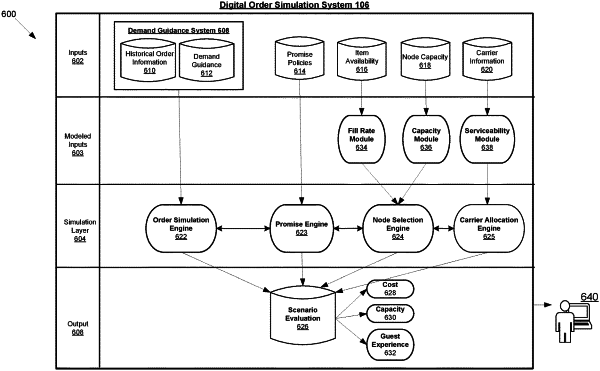| CPC G06Q 30/0202 (2013.01) [G06Q 10/08345 (2013.01); G06Q 10/087 (2013.01); G06Q 30/0631 (2013.01)] | 20 Claims |

|
1. A method for simulating fulfillment of digital orders within a retail supply chain network, the method comprising:
receiving a selection of a first operational parameter of a supply chain simulation model, the supply chain simulation model being a transaction-level model representative of a digital order fulfillment process within a retail supply chain network, the selection of the first operational parameter including a default value for the first operational parameter and an experimental value for the first operational parameter that is different from the default value;
simulating execution of a set of predicted digital orders within the retail supply chain network using the supply chain simulation model as modified in accordance with the first operational parameter, wherein simulating execution of the set of predicted digital orders includes:
retrieving historical order information and demand guidance from an external data store;
connecting to one or more live data feeds supplying live supply chain network data;
based on at least the live supply chain network data, using the supply chain simulation model and the default value for the first operational parameter to generate a baseline scenario of transaction-level operation of the retail supply chain network; and
based on the historical order information and demand guidance, performing one or more additional simulations executing the set of predicted digital orders using the supply chain simulation model and the experimental value for the first operational parameter to generate one or more modified scenarios of transaction-level operation of the retail supply chain network;
for the baseline scenario and each of the one or more simulations executing the set of predicted digital orders, aggregating transaction level data along a first vector for a plurality of predicted metrics associated with each of a cost, a capacity, and a guest experience for the digital order fulfillment process to generate a scenario evaluation;
comparing the scenario evaluation for each of the one or more simulations executing the set of predicted digital orders with the scenario evaluation for the baseline scenario by determining a difference in predicted metrics between the baseline scenario and each of the one or more simulations executing the set of predicted digital order; and
displaying, on a user interface, results based on comparing the scenario evaluations, wherein the results are displayed in one or more of a graphical and tabular format.
|